Six Degrees of Separation is an excuse to peruse six favourite books linked to an initial offering by our host KateW and eventually link them back to the beginning. Kate W offers us big themes in her choices and since I have been participating, these have included – being adrift in Time, Friendship, Memory, and Romance. This month we have the autobiographical exposé of the world of chefs, restaurants and bad boys generally – Anthony Bourdin’s Kitchen Confidential…

Full disclosure – I once, briefly but gloriously, ran my own restaurant so this month’s 6 Degrees starter book was one I could really get my teeth into! (There will be lots of food metaphors!) Anthony Bourdain’s “Kitchen Confidential” is a Chef’s story from a writer who self evidently writes, but counts himself first, foremost, and still practising – as a Chef. As he puts it – “If I need a favour at four o’clock in the morning, whether it’s a quick loan, a shoulder to cry on, a sleeping pill, bail money, or just someone to pick me up in a car in a bad neighbourhood in the driving rain, I’m definitely not calling up a fellow writer. I’m calling my sous-chef, or my saucier, someone I have worked with over the last twenty-plus years…” He writes about how a fairly obnoxious youth found his way into a profession where eccentricity, excess and general misdemeaning is mixed with skill, sweat and long hours in kitchens that come in many varieties, much like the seven circles of hell. He has a chapter in which he asks what possesses a man in mid-life to want to open a restaurant and whilst I was not quite as ignorant, inexperienced and deluded as the dentist Bourdin gives as an example, there were things I could identify with, although I enjoyed every minute of it and I now know, as Bourdin puts it “what it feels like to attain a childhood dream of running one’s own pirate crew…”. Anthony Bourdin writes clearly and entertainingly and for once I would agree with the blurb on the cover which states “More gripping than a Stephen King novel”
So in this month’s 6 Degrees, I am linking the books that made me a cook, a foodie and eventually, however briefly, a chef… When I left home to go to university, my parents bought me a Sabatier, high carbon-steel, flexible boning knife- something which Bourdin talks about in his chapter on essential equipment. They also bought me two paperback cookery books “The Pauper’s Cookbook” by Jocasta Innes, and “Cooking in a Bedsit” by the journalist Katherine Whitehorn.
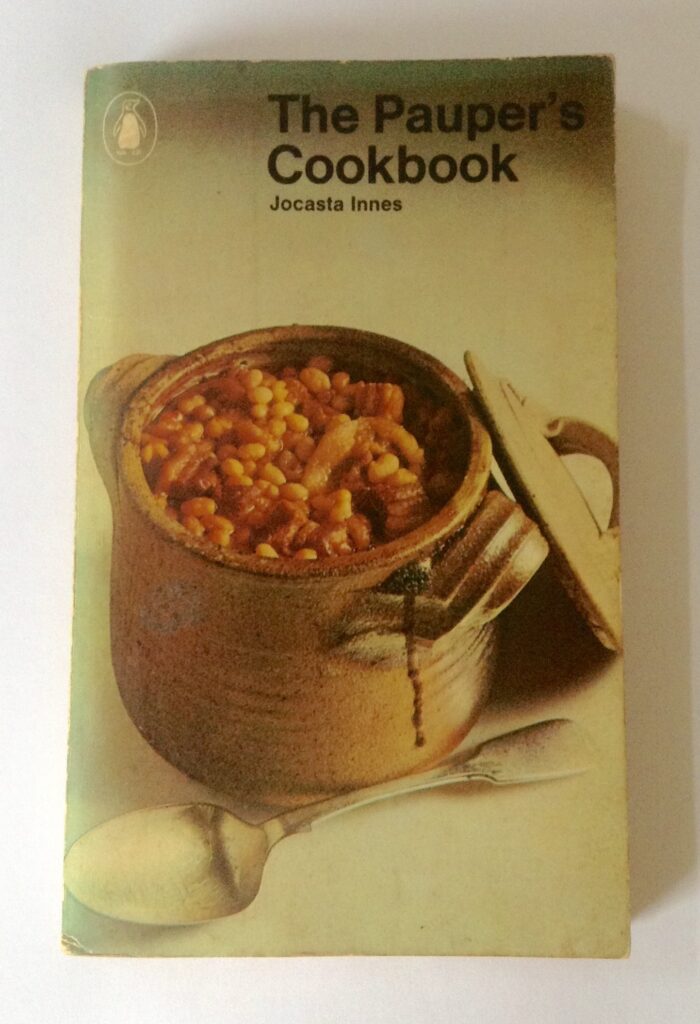
I should say, that heretofore, my mother had always refused to teach me to cook – unlike my sisters, who “would one day be married and therefore need to cook for their husbands” from which you may deduce that I grew up in the pre-liberation 1970’s – or at least Women’s Lib had not then reached our house! Not that I hadn’t kept my eyes and ears open and picked up some culinary skills just from watching my mother – and not just cooking meals, but bottling fruit, freezing vegetables and making jam. Nevertheless – the two books of recipes (or for any Americans – receipts) were intended to fill the gap in my education and fit the kind of cooking which my parents imagined would be the limit of what my student lifestyle would require. Incidentally, of myself and my two sisters, I was the only one who cooked professionally… What I chiefly remember about “Cooking in a Bedsit”, was not the recipes themselves which were sensible culinary cheats for the impecunious, but the structure of the book whose first section was entitled “Cooking on One Ring” followed by two rings and lastly, for those lucky enough to have access to one – cooking on a stove. There were also, entertainingly, short pieces on “For him Asking Her Round to Eat” and vice versa – the latter including the sage advice to make sure and remove all your drying knickers from the radiators before he gets there… This gave a hint as to the fact that food is not merely fuel, but a part of life and culture and this is also strongly themed in Kitchen Confidential. Jocasta Innes would return in a completely different field, later in my life, with her book Paint Magic which diverted me slightly from my career as a Signwriter to specialist paint finishes such as wood graining and marbling. And as for the Sabatier, well I have used it almost every day of my life since, including at least four food businesses and it has been worn down accordingly…

The thing is, I was slightly insulted by my parent’s offerings, implying that my culinary horizons would rise no higher than pauperdom and that once I had left bedsitter land, I would find a nice wife to do the cooking for me! So I set about building my now extensive collection of cookery and food books (three shelves in the bookcase now) by adding first Elizabeth David’s seminal “Mediterranean Food” closely followed by “The Joy of Chinese Cooking” by Doreen Yen Hung Feng and for international variety – the Penguin book of “Indian Cookery” by Dharamjit Singh. I did practise recipes from all these books, but I soon realised that on my cookery journey, reading recipe books and imbibing the essence of their method, ingredients and presentation, is more important than becoming an Indian, Chinese or Mediterranean cook per se – I was an early adopter of Fusion!

Elizabeth David was credited with revitalising British cuisine after the Second World War by both drawing attention to foreign food traditions but also, then researching and drawing out the best of British food traditions, subjects which had been, respectively, ignored and forgotten. She was also, a bit of a gal – as Wikipedia informs us “Born to an upper-class family, David rebelled against social norms of the day. In the 1930s she studied art in Paris, became an actress, and ran off with a married man with whom she sailed in a small boat to Italy, where their boat was confiscated.” I can only urge you to delve into Elizabeth David, both her books and her life story. Below is an example of her recipe for Tapenade and you will see that this is grownup recipe writing – she gives quantities for the main ingredients – capers and anchovies, but there is no spoon-feeding by detailing everything precisely – if you are a cook, you will understand and use your judgement. Also on these pages, is the recipe for Skordaliá which has remained my go-to dish when catering for mixed vegetarian and carnivores where I want to demonstrate that vegetarian food is far tastier and more interesting than a piece of meat and two veg…


“The Joy of Chinese Cooking” taught me how to think about putting dishes together in a considered way – the uninitiated way many groups at a Chinese restaurant assemble their order by each picking a favourite dish, whilst familiar to Chinese chefs and waiters the world over, must nevertheless fill them with horror every time. A Chinese meal should contain some whole elements such as a fish perhaps, some chopped and stir-fried and some dishes which are “assembled” – meaning elements cooked by different methods and then brought together in one dish. There should be a balance in red and white meat, fish and vegetable dishes – the whole meal being a balanced and considered effort. This book, first published I think, in 1950 (I am writing away from home so I can’t check my copy) has taught many people to cook Chinese home-style food and whilst some might find the recipes a little heavy by today’s standards and health consciousness, that is perhaps the nature of home cooking everywhere… Below is an example of the cultural differences expounded in the book.
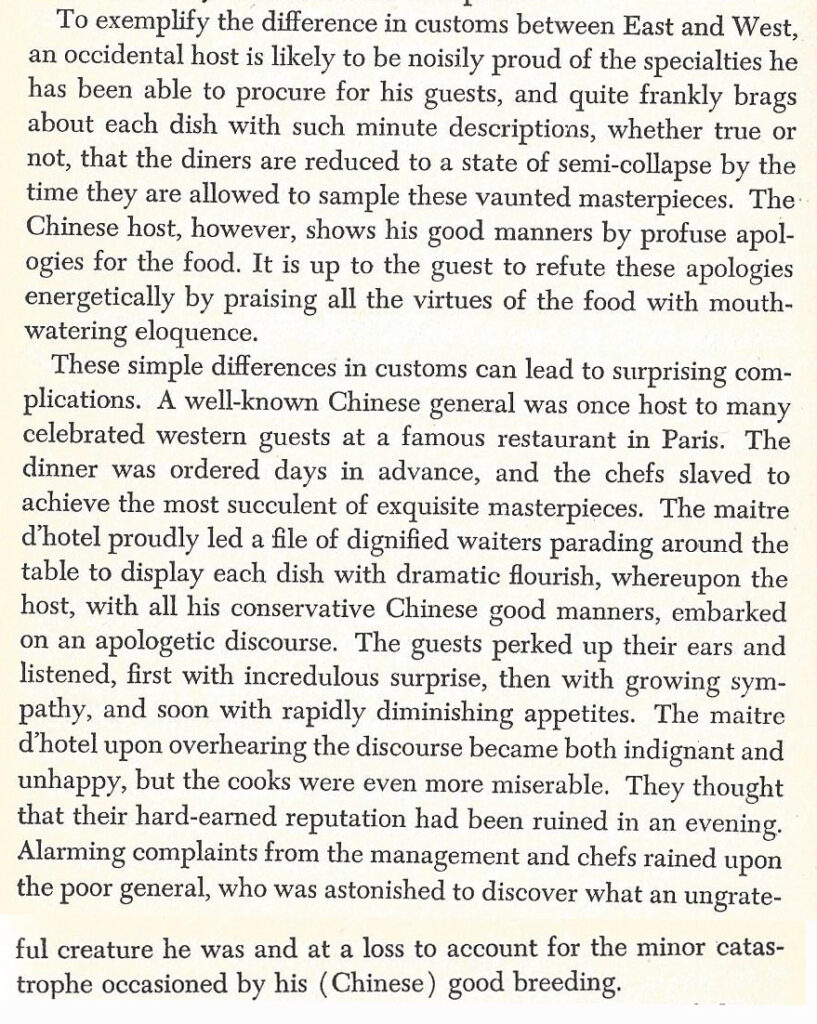
If Elizabeth David paints evocative word pictures of the dishes she encountered on her travels, Doreen Yen Hung Feng gives us a description of a whole food culture, sometimes anecdotally, as above, but also with some simple line drawings. Compared to today’s full-page colour photographs which present the recipes in impossible-to-equal perfection (no doubt with the aid of a food stylist and expert food photographer) Doreen’s illustrations are sparse, but her descriptions more than compensate and you will never be left feeling a failure when comparing your attempt with that in the photograph. The Penguin book of “Indian Cookery” is much the same – no pictures but a solid recipe book which has lasted through many editions as you would expect from Penguin the publisher
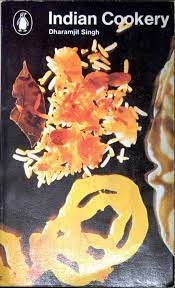
With “Indian Cookery” by Dharamjit Singh, I entered the pungent world of spices with their complex history and usage. Despite going to university in Birmingham (the city that gave us the diaspora invented Balti – a dish as unknown in India as Chop suey is unknown in China), I did not really go out for Indian meals until I lived in London, post-university and now I live and work in Bradford – Curry Capital of England! However, I did begin to dip my wooden spoon into yet another food culture and my ingredient shelf blossomed with yet more exotic substances. This is a source of friction between my partner and myself, as she is over-faced by the multiplicity of items she has no idea about in our kitchen and it is also a problem because unless you constantly use up your spices, they will stale.

My love affair with ingredients was developed by my next book choice – Tom Stobart’s “Herbs, Spices and Flavourings” which graced my bedside table for many years after university and many’s the time I read a few items of this splendid encyclopaedia of flavour before going to sleep. What I admired was that the author did not merely list the spices and herbs themselves, but delved into the nature of taste itself, the basic areas of taste detected by the tongue before the high notes which are detected in the nose (which is why food tastes of nothing much when our nose is blocked by a cold).
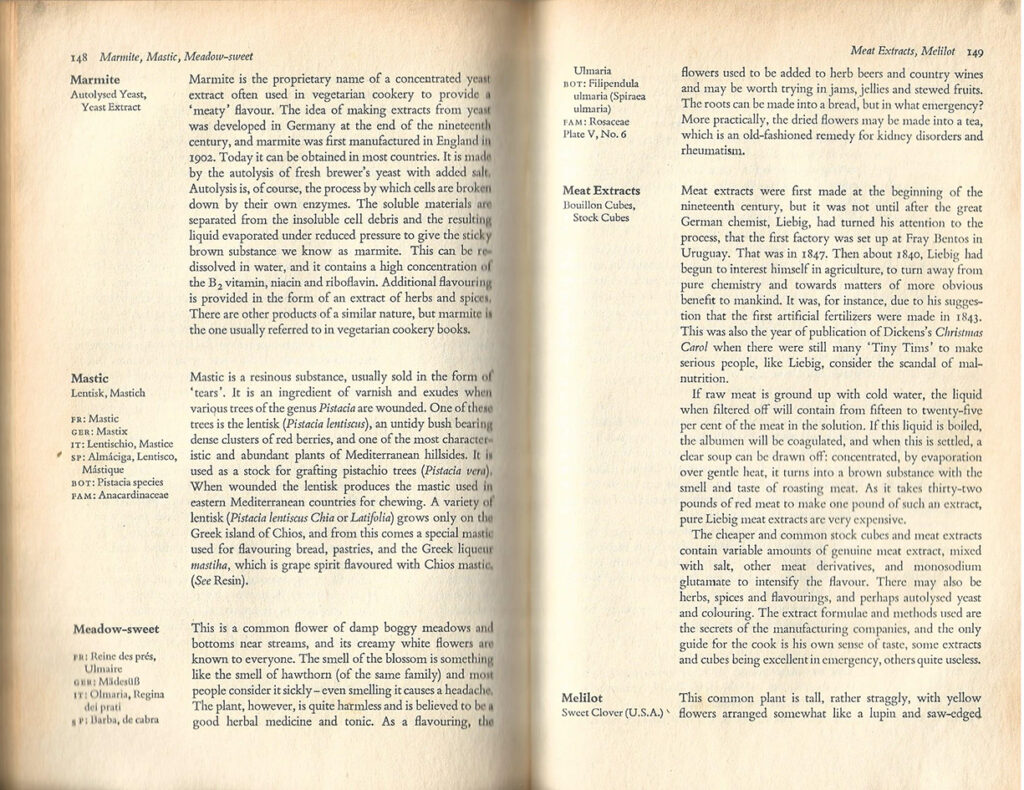
Tom Stobart also includes flavoursome items such as Marmite – that British food item which people famously “love or hate” – and in doing so, he legitimises the use of anything which has flavour for use as an ingredient which for a fusion foodie, encouraged cross-fertilisation of flavours from the different food cultures represented on my compendious ingredient shelf… In the extract above, you can see that below Marmite, Mastic the original chewing gum, is given its botanical name as well as the names by which it is known in various languages – what more could you ask for from an encyclopaedia?
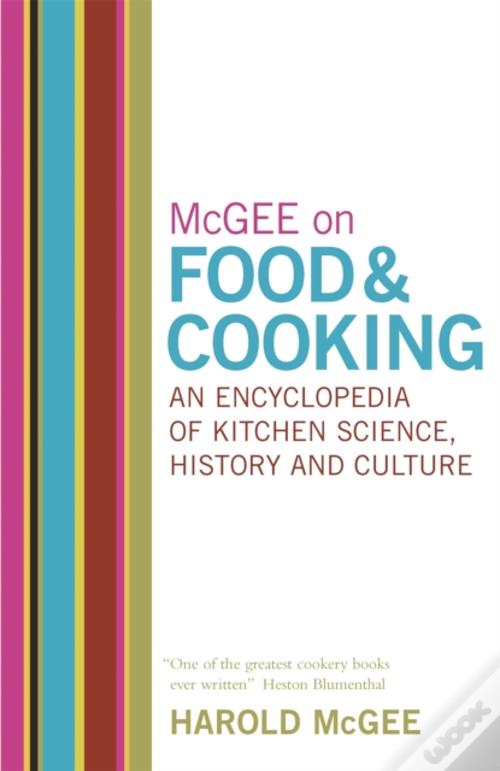
I was torn about my final choice of book because one of the weightiest tomes on my culinary bookshelves is also an encyclopaedia of enormous import which my partner bought for me one Christmas “McGee on Food and Cooking”. It is the bible of the scientific approach to cookery and is credited with inspiring so-called “molecular” chefs such as Heston Blumenthal. For me though, it is simply the go-to book when you need to understand why something works the way it does in cooking, such as how “No Knead” bread works when everyone knows that kneading bread is what develops the gluten that traps bubbles of carbon dioxide (given off by the yeast) and causes bread to rise. Cookery may be an Art or as the Greeks would have it, a Craft but understanding the Science does not destroy the Art anymore than understanding the science of why a sunset is red should take away our appreciation of the beauty of a sunset – quite the opposite! However, if this has not counted as sneaking in a seventh book, I eventually chose Nigel Slater’s “Toast” as my sixth link since it better closes the circle back to “Kitchen Confidential”.
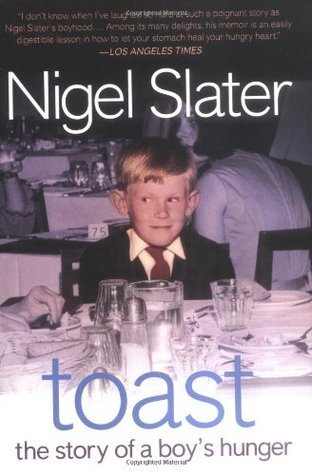
Nigel Slater recounts in a manner so entertaining that the book was dramatized for TV and the stage, how he became a chef – hence the link back to Anthony Bourdin. His mother was (now) famously, a terrible cook – so terrible that her long-suffering husband and only son, had, often, to ditch her burnt offerings in the bin and resort to the titular toast… After his mother died early, Nigel’s father remarried his cleaning lady, played, fruitily, in the TV drama by Helena Bonham-Carter who was at school in a class between my two sisters – how’s that for degrees of separation! The stepmother was a most excellent cook – in fact, that was part of the attraction for Nigel’s father and it meant that in Nigel’s perception, he found himself in a battle to win his father’s love and attention. The site of the battle was the kitchen as Nigel forced his way into domestic science (cookery) classes which in those days were usually reserved for girls and battle commenced – eventually equipping Nigel Slater to become not only a chef, but a celebrity chef, and like Anthony Bourdin, a chef who writes – both recipe books and his autobiography… So there you have my six (and a bit) choices all of which made me the reasonable cook/ sometime chef/ failed restauranteur I am today. My restaurant was not the first restaurant in which I cooked (I will not say Chef-ed) – that would be The Good Food Shop formerly of Lambs Conduit Street, London, where I blagged my way into cooking at weekends, became a manager/cook and learned a great deal about cooking, business and life – so I was not completely inexperienced when many years later, I opened my own restaurant “Frewin’s” (my middle name). Why did it fail? The obvious answer – not enough customers – was it the food, or the concept ( Café in the daytime, Bistro at night) – I like to think not. That summer it rained non-stop, so no walkers, no tourists and the people of the village went to the big newly revamped gastro pub (with café and massive umbrellas outside) and with copious car parking (of which I had none) and these things cannot always be seen in advance and so I lost my inheritance but as I said before, I enjoyed every moment of it. I hope you can also see why I enjoyed “Kitchen Confidential” so much…
What a tasty way to make this chain into a full circle! Bravo!
This was the most relatable starting point of any 6 Degrees so far so it was a pleasure…
Oh, I love this chain! How coud I have forgotten about The Pauper’s Cookbook, and Cooking in a Bedsit? They began my independent cooking life when I was a student. The McGee sits on my shelf too, but it’s more my husband’s ‘thing’ than mine. And of course I’ve read and enjoyed Toast too. I want to re-write my post to incorporate your first two choices now!
Such an enjoyable chain! I’m glad you snuck The Pauper’s Cookbook in. My partner had a copy when we first got together, an indicator that we might be in for the long haul and indeed we were although I’m not sure where the book’s gone.
I wonder how many people started their culinary lives with those two…
It’s some leap to the McGee but it is a most valued bible now…
Thanks for dropping by!
What a lovely and mouth-watering post. The Indian Cookery book is new to me, and the Chinese book looks lovely as well. Of course I am just a home cook but I do agree with cookbooks being just a way to explore new ingredients and combinations or even methods one can use without necessarily recreating a dish.
Most people in the world are home cooks – no “just” about it…
What a delightful post! I knew the vague outlines of David’s influence but knew little about her so appreciate what you shared. Someone gave me a tired paperback of Mediterranean Food and I need to take a closer look at it. I am more of a baker than a cook, unfortunately, but I do enjoy cookbooks.
A former colleague had a run in with Harold McGee (it was not her fault, or his, but she and I were trying to fix the situation and it was very awkward).
This is a lovely six degrees chain. I enjoy cookbooks although I am not much of a cook nowadays. On your list I especially like McGee on Food and Cooking and Toast by Nigel Slater. Being in the US I am not very familiar with these but they sound very good. When I got married the first time in 1971 I had not cooked much at all and I had The Joy of Cooking by Irma Rombauer and Marion Rombauer Becker. I wish that I had kept that book. My current husband and I bought the Dairy Hollow House Soup & Bread Cookbook by Crescent Dragonwagon, which we still have. For years my specialty was cooking soups.
Thanks for stopping by my blog and commenting on my Six Degrees.
TracyK at Bitter Tea and Mystery
FASCINATING post! And, Americans say “recipes” not receipts for what you cook from. lol No matter–this is all so interesting. I want to read all of these!!
Soup is great – I am on holiday in Portugal and just made a soup with fish, sweet potato, peppers and beans…
so may treasures here, thanks for your thorough linking
I absolutely love this story and will revisit it with thoughts of my/our food journey. I’m sharing it with my other half who has taken on the role of chef of our kitchen so I’m well looked after 🙂 I used to cook well but rarely cook now, but I’m a great finder of really good recipes.
I would love to hear your food story, Pauleen – go for it!